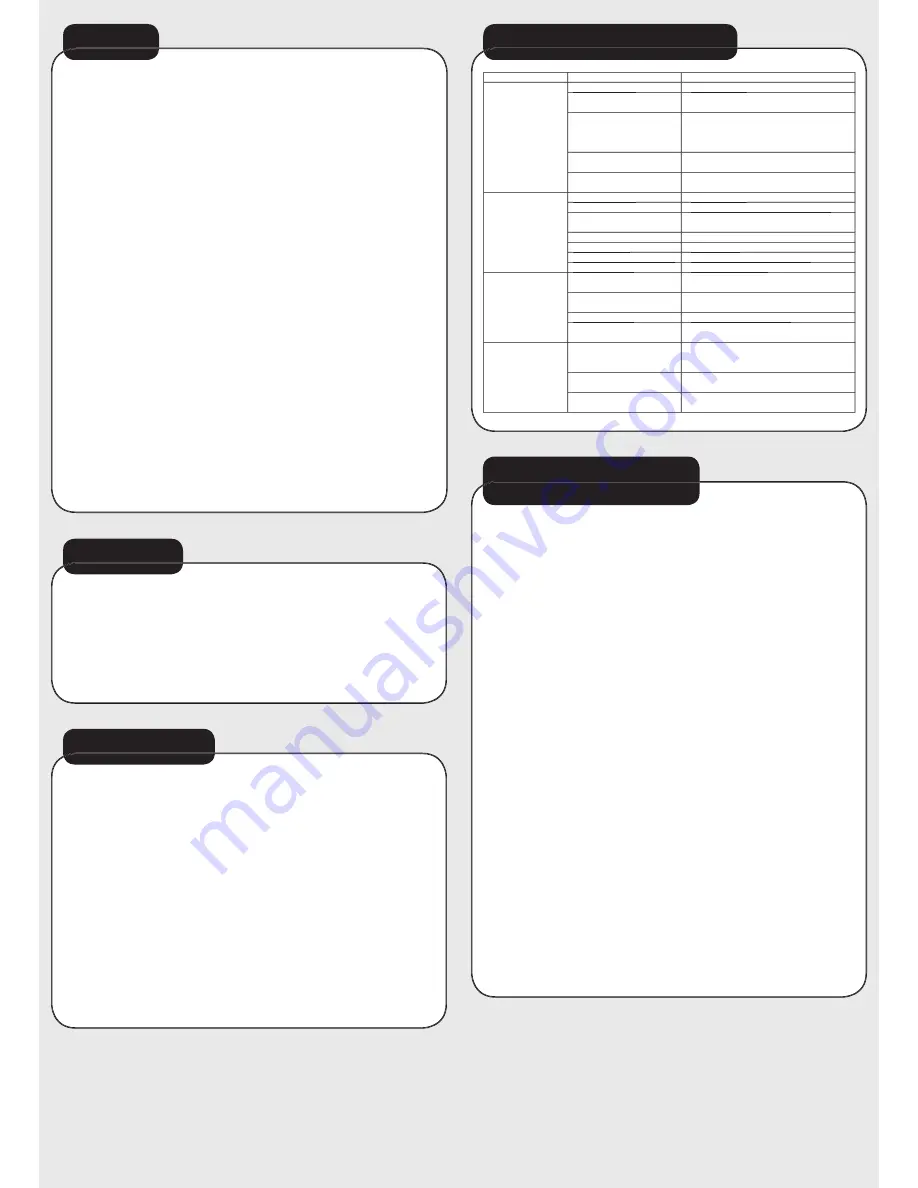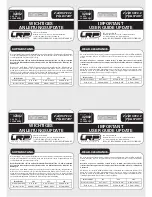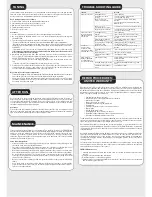
TROUBLE SHOOTING GUIDE
TUNING
AFTER RUN
MAINTENANCE
REPAIR PROCEDURES /
LIMITED WARRANTY
It never hurts to have the mixture too rich, but NEVER let the mixture get too lean. Always tune
from rich to lean. If in doubt, richen it up fi rst! Never try to tune a cold engine, run 3-5 minutes to
get the engine up to running temperature before doing any adjustments!
Basic tuning procedure is as follows:
1. Set the engine’s idle speed up slightly higher than normal.
2. Start tuning your engine with the settings too rich.
3. Always tune main-speed needle (top-end) fi rst.
4. Tune mid-range needle next.
5. Reset idle speed screw.
Procedure:
1. Set the idle speed so your engine doesn’t stall (slightly higher then normal).
2. Go to the track with the main-needle set too rich, there should be heavy smoke coming from
the muffl er now.
3. Tune the engine by leaning the main-needle 1/8 turn at a time (turn clockwise).
- Your goal will be that the engine will just reach maximum RPM on the straightaway.
- Open the main-needle again by an 1/8 turn (turn counter-clockwise) when you have reached
that point. This should be the perfect setting for the main-needle (temperature of 110-130°C /
230-266°F).
- If the main-needle is set too lean, the engine will overheat and will not accelerate smoothly.
If this happens, immediately stop the engine and richen the main-needle (counterclock-
wise) 1/4 turn before a new attempt.
4. Adjust the mid-range needle now. Run 3 full laps, stop the car near you and let it idle for
5secs. „Push off“. It should have slightly richened up (idle rpm gets lower), but still accelerate
quickly. If it died before the 5secs, check the following:
- If the rpm constantly decreases and fi nally the engine stops, the mid-range needle is too
rich.
- If the idle-speed increases during idle, the mid-range needle is too lean.
5. You may have to re-adjust the idle-speed now. If it idles too high, the clutch may not release
completely and you will lose „snap“ off the corners. If it idles too low, it may stall at the start,
or at the end of the straightaway when you release the throttle.
Ways to measure the engine temperature:
• Temperature gauge method (recommended): Pull in quickly and immediately take a tempera-
ture reading. Place the gauge directly over the engine pointed at the glow plug.
• Spit method: Pull in quickly and immediately put some spit on the engine’s head. The spittle
should just slowly boil off (2-3secs). It should not dance around as if it were on a hot griddle,
nor should it lay there and steam.
Use after-run oil to keep everything lubricated after you have fi nished your day. After-run oil
helps for an easy start the next time and protects your internals against rust. Use only „after-run
oil“ specially formulated for R/C engines. Do not use silicone shock oil or similar as they will
seriously harm your engine. We recommend to use our LRP After-Run oil (No. 37910), which you
should use regularly after using your engine.
Procedure:
First let the tank run completely empty at idle until it runs out of fuel (try re-starting it several
times), next put a few drops down the open carburetor and a few drops down the glow plug hole.
Spin it over with the Pullstart at least 5 times and you are done.
Treat your engine with care and check it frequently. This engine will rev up to 33.500 RPM and
any fault at such high RPM can cause serious damage. All moving parts inside the engine are
subject to wear, you must know if a piston/liner/conrod has worn out and if they need to be
replaced. If you replace one part, please check if everything else is still in good shape at the
same time. If you only change one part and other parts are in bad shape, there’s the possibility
that there will be a new failure soon!
Some important matters:
• Clean the outside of the engine properly before you open it. Any dust or dirt which gets into
the engine could make considerable damage.
• Check the conrod frequently. If you want to replace the conrod, be sure the big end of your
crankshaft is still round and at a good size. If not, also replace the crankshaft.
• When you start putting your engine back together, make sure that each part is totally clean
before installation and please use some oil (after-run is suited well) to lubricate everything.
• Be careful that each part has its correct direction, especially piston/liner/conrod. Both the
lower part of the piston and the lubrication hole in the conrod should be facing to the front
(direction to the carburetor).
• Before you install the combustion chamber, please doublecheck that you installed all head
shims.
• Use a hex wrench to install the screws. When you start to feel resistance, stop turning the
screw. Repeat this for each screw, use the star-technique to tighten all the screws complete-
ly. Do not overtighten them!
PROBLEM
REASON
SOLUTION
Engine does not start
Glow plug defective
Glow plug defective
- replace glow plug
replace glow plug
Glow plug does not work
properly
- check the condition of the glow plug
- check the glow plug igniter
Engine is set too rich
(too much fuel, hits back)
- check carburetor settings, repeat tuning
procedure
- unscrew the glow plug completely and pull the
Pullstart 5 times
Engine is too lean
(too little fuel, does not start)
- check carburetor setting, repeat tuning procedure
Engine doesn’t suck in the fuel
- check the fuel line for possible damage
- check the carburetor setting
Engine stops after a
short time after glow
plug igniter has been
disconnected
Glow plug defective
Glow plug defective
- replace glow plug
replace glow plug
Bad fuel
- replace fuel by fresh and correct type of fuel
replace fuel by fresh and correct type of fuel
Bad carburetor setting
- check the carburetor setting, repeat tuning
procedure
Dirt in fuel line or carburetor
- clean fuel line, clean & check carburetor
Fuel line damaged
Fuel line damaged
- replace fuel line
replace fuel line
Loose glow plug or cooling head
Loose glow plug or cooling head
- tighten glow plug and/or cooling head
tighten glow plug and/or cooling head
Air fi lter old or dirty
Air fi lter old or dirty
- clean or replace air fi lter
clean or replace air fi lter
Performance
decreases after
reaching operating
temperature or engine
stalls from time to time
Engine is set too lean
- check the carburetor setting, repeat tuning
procedure
Glow plug defective or wrong
type
- replace the glow plug by a correct type
Engine runs too hot
Engine runs too hot
- run-in process is not completed
run-in process is not completed
Shims under comb. chamber
wrong
- check number of shims
Engine still keeps
running at high RPM
for a moment when
you release the throttle
Bad carburetor setting
- open mid-range needle ¼ turn at a time and
re-adjust idle-speed
- set idle speed lower
Glow plug, wrong type (too hot)
- use glow plug with higher number (e.g. go from
5 to 6)
Shims under comb. chamber
wrong
- check number of shims
All products from LRP electronic (hereinafter called “LRP”) are manufactured according to the
highest quality standards. LRP guarantees this product to be free from defects in materials or
workmanship for 90 days from the original date of purchase verifi ed by sales receipt. This limited
warranty doesn’t cover defects, which are a result of normal wear, misuse or improper mainte-
nance. This applies among other things on:
• Engine disassembly by customer
• Any modifi cation of the engine done by the customer
• Rust inside the engine
• Dust or dirt inside the engine
• Damaged engine due to glow plug failure
• Overheating
• Scratches inside the engine caused by dirt or dust
• Water in fuel
• Wrong break-in procedure
• Damaged piston due to piston stop devices
• Damaged cylinder exhaust port due to piston stop devices
• Breakages at high rpm without engine load
To eliminate all other possibilities or improper handling, fi rst check all other components and the
trouble shooting guide before you send in this product for repair or warranty. Products sent in for
repair, that operate perfect have to be charged with a service fee.
By sending in this product, you assign LRP to repair the product, if it is no warranty case. The
original sales receipt including date of purchase needs to be included. Otherwise, no warranty
can be granted. For quick repair- and return service, add your address and detailed description
of the malfunction.
Our limited warranty liability shall be limited to repairing the unit to our original specifi cations.
In no case shall our liability exceed the original cost of this unit. Because we don’t have con-
trol over the installation or use of this product, we can‘t accept any liability for any damages
resulting from using this product. By installing or operating this product, the user accepts all
resulting liability.
The specifi cations like weight, size and others should be seen as guide values. Due to ongoing
technical improvements, which are done in the interest of the product, LRP does not take any
responsibility for the accuracy of these specs.
LRP-Distributor-Service:
• Package your product carefully and include sales receipt and detailed description of mal-
function.
• Send parcel to your national LRP distributor.
• Distributor repairs or exchanges the product.
• Shipment back to you usually by COD (cash on delivery), but this is subject to your national
LRP distributor‘s general policy.





















